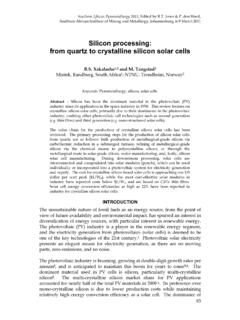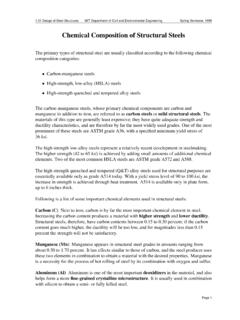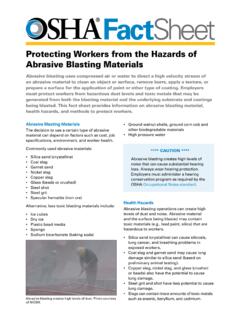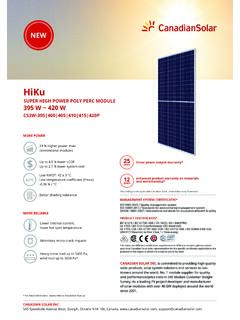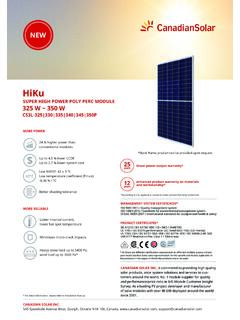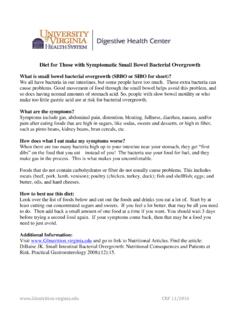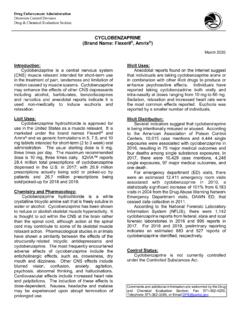Transcription of Porous, Crystalline, Covalent Organic Frameworks Adrien P ...
1 DOI: , 1166 (2005); 310 Science et P. C t ,Porous, crystalline , Covalent Organic Frameworks (this information is current as of March 28, 2007 ):The following resources related to this article are available online at of this article at: including high -resolution figures, can be found in the onlineUpdated information and services, can be found at: Supporting Online Material 22 article(s) on the ISI Web of Science. cited byThis article has been : subject collectionsThis article appears in the following in whole or in part can be found at: this articlepermission to reproduce of this article or about obtaining reprintsInformation about obtaining registered trademark of AAAS.
2 C 2005 by the American Association for the Advancement of Science; all rights reserved. The title SCIENCE is a CopyrightAmerican Association for the Advancement of Science, 1200 New York Avenue NW, Washington, DC 20005. Science (print ISSN 0036-8075; online ISSN 1095-9203) is published weekly, except the last week in December, by the on March 28, 2007 from in the ground state, replacing it with some sortof quantum vortex liquid ground state; or sec-ond, that the superflow is being damped bysome temperature-dependent mechanism otherthan vortices (transverse phonons andumklappare two possibilities that are not present in theliquid phase), and this damping only vanishesat zero temperature.
3 Note that here we arealways discussing the damping at linear orderin the apparent superfluid velocity, thus in lin-ear response to the solid_s motion. The actualsupersolid transition is where this rate of damp-ing vanishes, so one can have a true superflowin linear response. From these recent experi-ments at just the one frequency (2), we cannotdetermine where this transition actually hap-pens, or whether it does happen even at zerotemperature, although weshould conclude fromtheir data that the supersolid transition temper-ature must be below the dissipation feature,which puts it below 50 mK (14).
4 The results ofsimilar experiments at other frequencies shouldbe and Notes1. E. Kim, M. H. W. Chan,Nature427, 225 (2004).2. E. Kim, M. H. W. Chan,Science305, 1941 (2004).3. A. F. Andreev, I. M. Lifshitz,JETP29, 1107 (1969).4. B. A. Fraass, P. R. Granfors, R. O. Simmons, B39, 124 (1989).5. C. A. Burns, J. M. Goodkind,J. Low Temp. ,695 (1994).6. W. R. Gardner, J. K. Hoffer, N. E. Phillips,Phys. Rev. , 1029 (1973).7. S. M. Heald, D. R. Baer, R. O. Simmons,Phys. Rev. B30, 2531 (1984).8. D. S. Greywall,Phys. Rev. B15, 2604 (1977).9. P.
5 W. Anderson,arXiv, cond-mat/0504731, 7 B. Chaudhuri, F. Pederiva, G. V. Chester,Phys. Rev. B60, 3271 (1999).11. D. M. Ceperley, B. Bernu,Phys. Rev. , 155303(2004).12. D. E. Galli, M. Rossi, L. Reatto,Phys. Rev. B71, R. O. Simmons, private communication (2005).14. In the qualitatively similar oscillator data for super-fluid4He films near their Kosterlitz-Thouless tran-sitions, the actual transition temperature is well belowthe dissipation feature (15).15. D. J. Bishop, J. D. Reppy,Phys. Rev. , 1727(1978).16. We thank M. Chan, R. Simmons, and D.
6 Greywall forhelpful discussions. This work was supported in part( ) by NSF through grant August 2005; accepted 13 October 2005 Published online 3 November 2005; this information when citing this , crystalline , CovalentOrganic FrameworksAdrien P. Co te ,1*Annabelle I. Benin,1 Nathan W. Ockwig,1 Michael O Keeffe,2 Adam J. Matzger,1 Omar M. Yaghi1* Covalent Organic Frameworks (COFs) have been designed and successfullysynthesized by condensation reactions of phenyl diboronic acid {C6H4[B(OH)2]2}and hexahydroxytriphenylene [C18H6(OH)6]. Powder x-ray diffraction studiesof the highly crystalline products (C3H2BO)6&(C9H12)1(COF-1) and C9H4BO2(COF-5) revealed expanded porous graphitic layers that are either staggered(COF-1,P63/mmc) or eclipsed (COF-5,P6/mmm).
7 Their crystal structures areentirely held by strong bonds between B, C, and O atoms to form rigid porousarchitectures with pore sizes ranging from 7 to 27 angstroms. COF-1 and COF-5exhibit high thermal stability (to temperatures up to 500-to 600-C), perma-nent porosity, and high surface areas (711 and 1590 square meters per gram,respectively).The design and synthesis of crystalline ex-tended Organic structures in which the buildingblocks are linked by strong Covalent bonds areundeveloped areas of research. It is widelybelieved that the required microscopic revers-ibility of the crystallization of linked organicmolecules into such solids is difficult if notimpossible to achieve (the crystallizationproblem).
8 The lack of crystalline cross-linkedpolymers is often cited as evidence in supportof this view (1).Recently,weembarkedonaprogram aimed at challenging this notion byconstructing porous, crystalline , Covalent or-ganic Frameworks (COFs) solely from lightelements(H,B,C,N,andO)thatareknownt oform strong Covalent bonds in well-establishedand useful materialssuch as diamond, graph-ite, and boron nitride. The successful realizationof COF materials through molecular buildingblocks would provide Covalent Frameworks thatcould be functionalized into lightweightmaterials optimized for gas storage, photonic,and catalytic report a general design strategy and itsimplementation for the synthesis and crystalli-zation of micro- and mesoporous crystallineCOFs.
9 These materials have rigid structures,exceptional thermal stabilities (to temperaturesup to 600-C), and low densities, and theyexhibit permanent porositywithspecificsurfaceareas surpassing those of well-known zeolitesand porous silicates. The first two members,COF-1E(C3H2BO)6&(C9H12)1^and COF-5(C9H4BO2), can be synthesized using a simpleBone-pot[procedure under mild reactionconditions that are efficient and date, attempts to prepare COFs havegenerally focused on synthesizing porous or-ganic polymers with nonordered structures ordensely packed linear polymers that have one-dimensional (1D) crystalline structures (1 6).]
10 An approach involving indirect multistep syn-thesis of open Frameworks templated frommolecular solids has also been pursued, butdoes not give crystalline or fully linked ma-terials (7,8). Our strategy for synthesizingcrystalline COFs involves using one-step con-densation reactions of discrete molecules knownto produce six- and five-membered rings thatcan be appropriated for the synthesis of theirextended analogs, as shown in Fig. synthesis of COF-1 is based on themolecular dehydration reaction (Fig. 1A), inwhich three boronic acid molecules converge toform a planar six-membered B3O3(boroxine)ring with the elimination of three water mol-ecules.


